How deep to plant potatoes
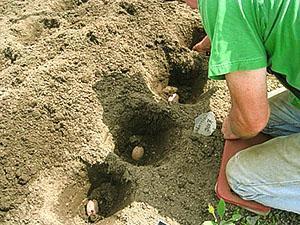 Potatoes are the most common agricultural crop grown in backyards and summer cottages. At the same time, despite the similarity of its agricultural technology in different regions of our country, there is some difference in the methods of planting tubers. That is why the question of how deep plant potatoes, worries many, including novice gardeners.
Potatoes are the most common agricultural crop grown in backyards and summer cottages. At the same time, despite the similarity of its agricultural technology in different regions of our country, there is some difference in the methods of planting tubers. That is why the question of how deep plant potatoes, worries many, including novice gardeners.
What determines the depth of planting tubers
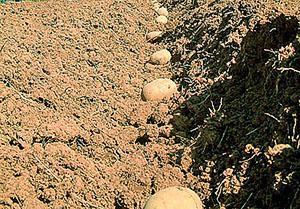 There are various ways of planting this crop: in holes, in ridges, under a shovel or in furrows. Moreover, the depth of embedding of tubers can vary from 5 cm to 30 or more centimeters. What determines the planting depth of potatoes?
There are various ways of planting this crop: in holes, in ridges, under a shovel or in furrows. Moreover, the depth of embedding of tubers can vary from 5 cm to 30 or more centimeters. What determines the planting depth of potatoes?
It is determined by several different factors. These include:
- Soil type and composition... On light and loose soils, the depth of embedding of tubers can be greater, since such a soil allows air to pass through quite well, which allows the plant to develop rapidly and give many underground stolons, on which a large number of tubers are tied. On dense soils, the potato planting depth can be 5-8 cm.
- Tuber size. Typically, larger tubers are planted deeper than smaller tubers, as they contain a greater supply of nutrients, which allows the stems to develop faster and more actively.
- Type of planting material. Very often, to save planting material, gardeners practice cutting the tubers into pieces. Each of them should have several eyes or sprouts. The cut should be well dried and treated with wood ash. Such planting material is usually embedded to a depth of no more than 5-8 cm.
Potato planting methods
Answering the question of how to plant potatoes correctly, it is difficult to say which method of planting tubers is the most effective. In different conditions, they all show different results. There are several popular ways to plant this crop.
The choice of the method of planting potatoes is determined by the features of the relief of the site, the cultivation region, the level of groundwater, and the personal preferences of the gardener.
The most common ways to plant tubers are:
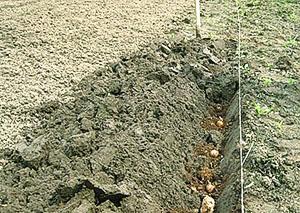 Under the shovel. In small-sized vegetable gardens, many still plant tubers “under a shovel”. This means that they are embedded almost to the depth of the shovel bayonet. This method of planting potatoes is quite justified on light and loose soils, where the groundwater is located quite deep. When planting potatoes "under a shovel", in the future, many restrict themselves to creating small earthen mounds around the stems of the plant, since the bulk of the productive stolons is deep in the ground and there is no need to shovel a lot of soil onto the plant.
Under the shovel. In small-sized vegetable gardens, many still plant tubers “under a shovel”. This means that they are embedded almost to the depth of the shovel bayonet. This method of planting potatoes is quite justified on light and loose soils, where the groundwater is located quite deep. When planting potatoes "under a shovel", in the future, many restrict themselves to creating small earthen mounds around the stems of the plant, since the bulk of the productive stolons is deep in the ground and there is no need to shovel a lot of soil onto the plant.- Into the ridges. This option is ideal for wet soils. The tubers are planted in ridges, the height of which is 15-20 cm. For their formation, gardening equipment or a mini tractor is most often used.
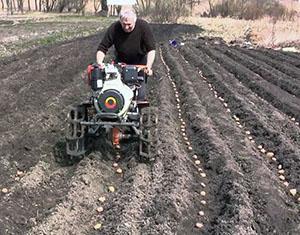 In the trenches. For this method, furrows are used, 10-20 cm deep. Their bottom is filled with rotted humus. The planting material is spud from both sides, forming a ridge above it, 10 cm high and 20 cm wide.
In the trenches. For this method, furrows are used, 10-20 cm deep. Their bottom is filled with rotted humus. The planting material is spud from both sides, forming a ridge above it, 10 cm high and 20 cm wide.- "Under the straw." This option is used on uncultivated land. They do not dig the soil at all. Cover the tubers with a thick layer straw... As the stems grow, its amount gradually increases.
- Scoop into the holes, 10 cm deep.This method is most often used for growing early varieties of potatoes on light to loose soils.
- Before winter in the holes. Some gardeners in temperate latitudes, where winters are not too harsh, plant potatoes in late summer. This planting method allows you to get a very early harvest next spring. Areas well protected from the wind are suitable for planting. In summer, one tuber is planted in the prepared holes. When the stems appear, they are spud. Before the onset of frost, the tops are cut off. The combs with potatoes are covered with straw, spruce branches or fallen leaves.
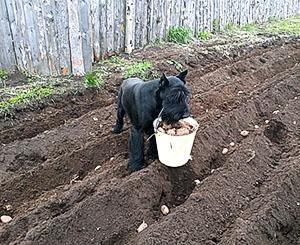 Many people ask themselves: at what distance to plant potatoes? It depends on the size of tubers, potato variety, planting method. There are various planting patterns, the most popular of which are:
Many people ask themselves: at what distance to plant potatoes? It depends on the size of tubers, potato variety, planting method. There are various planting patterns, the most popular of which are:
- distance between tubers - 40-50 cm, row spacing - 50-70 cm;
- early varieties are planted with an interval of 30-35 cm, row spacing - 50 cm.
Preparation of planting material
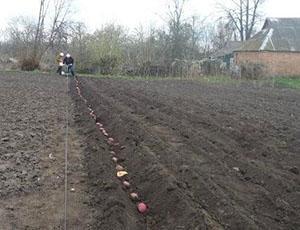 Tubers intended for planting must be intact, without signs illness or mechanical damage. 2-3 weeks before planting tubers in the ground, they are germinated at a temperature of about 15-18 ° C. After the sprouts reach 0.5-1 cm, the planting material is taken out for 1-2 days. This pre-planting preparation of tubers allows you to get potato bushes with a large number of stems and stolons.
Tubers intended for planting must be intact, without signs illness or mechanical damage. 2-3 weeks before planting tubers in the ground, they are germinated at a temperature of about 15-18 ° C. After the sprouts reach 0.5-1 cm, the planting material is taken out for 1-2 days. This pre-planting preparation of tubers allows you to get potato bushes with a large number of stems and stolons.
The tubers are usually planted manually. Less commonly, various gardening techniques are used. A very useful device is a potato planter. You can buy it at a specialty store or do it yourself. It not only facilitates the physical work of a person, but also allows you to get more even and beautiful rows of potatoes.
Land cultivation after planting
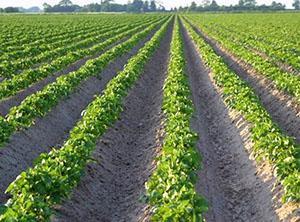 Since tubers are formed on the lateral shoots of a plant, after planting them, it is imperative to spud the stems several times per season at intervals of 2 weeks until the greens close between the rows. At the same time, mounds of earth are formed around the plant. They not only promote the formation of more tubers, but also protect young plants from late frost.
Since tubers are formed on the lateral shoots of a plant, after planting them, it is imperative to spud the stems several times per season at intervals of 2 weeks until the greens close between the rows. At the same time, mounds of earth are formed around the plant. They not only promote the formation of more tubers, but also protect young plants from late frost.
Planting depth of potatoes - video
Thanks for the information on planting potatoes. What a adapted root crop it is. In one place he has enough straw on the surface to get a crop, in another he can come out from a depth of 30 cm, in the third, planting is done in winter. It turns out that the plant adapts to any conditions at the first stage of development. I heard from Belarusians that they plant seeds on virgin soil, lifting the earth with a shovel and lowering the tuber into the gap formed. And with the help of such a landing, they develop a pillar. I tried to plant several bushes, the yield was not outstanding, average. From this I conclude that the tuber does not tolerate cold soil, freezing temperatures during the growing season and freezing of the tubers during storage. For the rest, it will grow up and feed the people with the second bread.
I plant deeply - on the bayonet of a shovel, but cover it with a small layer of earth. but then, as I grow, I add it, and then I did it well. When the potatoes were dug, they ended up deep in the ground, can this affect the yield?